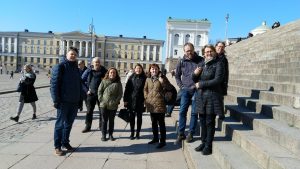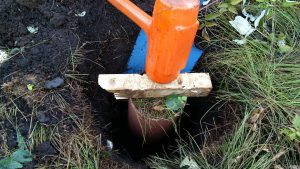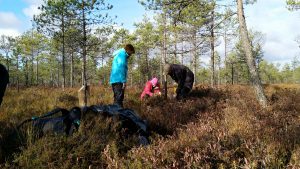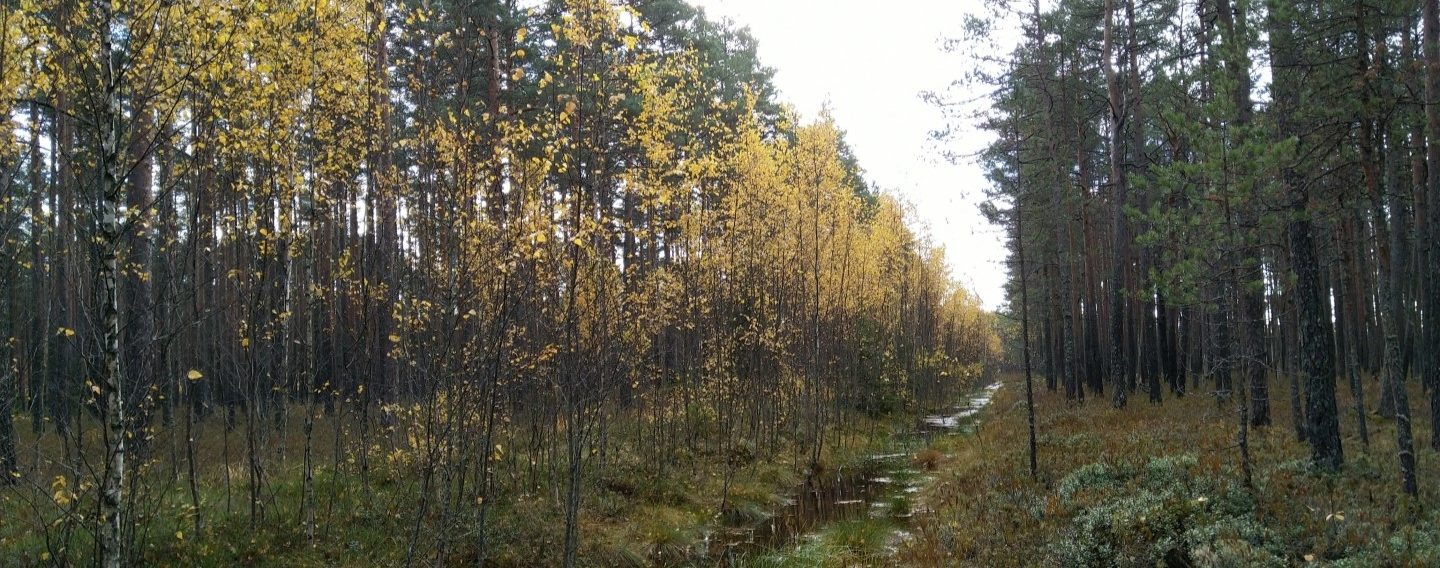The largest lakes in Nordic countries, which are among the most important raw water supplies for the major cities, are showing brownification i.e. increase in dissolved organic matter and humic substances. This phenomenon, common across much of the northern latitudes, has primarily been suggested to result from processes related to the recovery from acid deposition and increase in winter precipitation. However, in the Nordic countries, land use primarily related to forest management on drained peatlands has also been shown to play an important role in the large scale brownification. As the demand for timber, pulpwood, renewable energy sources and biodegradable materials is increasing, there is an ongoing pressure to use the large timber stock on drained peatlands and to carry out ditch network maintenance (DNM) to allow for reestablishment of new forests. There is significant timber stock in the large drained peatland forests that are soon coming to harvesting age. Since 62-72% of the land area in these countries is covered by forests of which up to 25% on drained peatlands, related increases in dissolved organic matter (DOM) and accompanying nutrient fluxes from such forest under management regime is a major threat to water quality. Large scale DNM will possibly result in increased brownification and eutrophication of water bodies, thus affecting the water quality in recipient water bodies.
AIM OF THE PROJECT
The aim of this JPI-Water funded project is to quantify the effects of current management practices (harvesting and subsequent ditch network maintenance (DNM)) on peatland forests on the transport of DOM and its quality to aquatic systems. In addition, we will develop a novel tool based on biochar application to decrease the DOM and nutrient load on aquatic systems. Finally, we aim to develop state-of the art process-modelling techniques for assessing the effects of forest management practices on water quality in peatland-dominated catchments, and for optimizing the production in such a way that enables wood production while keeping the adverse environmental impacts to a minimum.
The project will be based on field experiments where the effects of different forest management techniques on water quality are tested. We will also carry out detailed laboratory experiments for determining the effect of DOM quality on greenhouse gas production from aquatic systems. The project is based on multidisciplinary collaboration between foresters, soil scientists and limnologists.
 REFORMWATER Kickoff meeting in Helsinki in April 2019. From the left: Kajar Köster, Frank Berninger, Eliza Maher-Hasselquist, Marjo Palviainen, Anne Ojala, Hjalmar Laudon, Ivika Ostonen and Annamari Laurén. REFORMWATER kickoff meeting in Helsinki in April, 2019 (From the left: Kajar Köster, Frank Berninger, Eliza Maher-Hasselquist, Marjo Palviainen, Anne Ojala, Hjalmar Laudon, Ivika Ostonen, Ari Laurén.
PARTNERS OF THE PROJECT
University of Eastern Finland, University of Helsinki, Swedish University of Agricultural Sciences, University of Tartu, University College Dublin
| PROJECT STRUCTURE
WP 1. Less-invasive forest management as a tool for reducing DOM load
In this WP, we will study potential ways to reduce the DOM and nutrient load from forested peatland catchments using different forest management options and biochar. We will compare the DOM export in experimental areas in following treatments: 1) uncut control forest, 2) thinning with ditch network maintenance, 3) clearcutting with ditch network maintenance and 4) continuous cover forestry without ditch network maintenance and after clear-cut and ditch network maintenance (treatment 5). The quality i.e. biodegradability of DOM will be determined from the water samples with incubation experiments and using molecule level cutting-edge techniques such as the FT-ICR-MS
|
| WP 2. Biochar as a potential tool for reducing the export of DOM and inorganic nutrients to inland waters
In this WP, we will test the potential of biochar for capturing the inorganic nutrients and DOM released from the soil and therefore it decreases the nutrient export load. For testing this hypothesis, we will develop filters made of biochar for removing DOM and inorganic nutrients from water running in the ditches in the ditch network maintenance areas.
|
| WP 3. Model-based tool for combined planning of peatland forest management operations and biochar filtering aiming to decrease DOM export load to water courses
In this WP, we will combine the experimental results from WP1-2 to develop a state-of-the-art process-based simulation model calculating the fate of DOM from peat to ditch, and through water protection filter to water bodies, and finally in the form of CO2 to the atmosphere.
OUTCOMES AND EXPECTED IMPACT
The project will develop novel methods and protocols for decreasing the effect of forest management operations on aquatic systems and quantifies the effects of forest management operations on water quality. We will also develop supporting tools for sustainable integrative management of water resources .i.e. a model-based tool for reducing the impact of forest management on aquatic systems.
FUNDER OF THE PROJECT
| Water-JPI, Finland (Academy of Finland), Sweden (A Swedish Research Council for Sustainable Development, FORMAS), Estonia (Estonian Research Council, ETAG), Ireland (Environmental Protection Agency, EPA)
EXPERIMENTS
Finland: Paroninkorpi research area in Southern Finland, long-term field experiment for testing the effects of different forest management options on forest carbon balance, greenhouse gas emissions and water quality in peatlands (treatments: clear-cut, continuous cover forestry and ditch network maintenance). Column experiment for studying the effect of ditch network maintenance on soil organic matter decomposition, DOM formation and DOM quality. Columns will be collected from all sites in Finland, Sweden, Estonia and Ireland for a joint column experiment to be carried out in the laboratory in Finland.
| Sweden: Krycklan catchment in Northern Sweden, long-term field experiment for testing the effects of ditch network maintenance on water quality, greenhouse gas emissions and forest carbon balance
Estonia: Järvseljä experimental area in Southern Estonia, long-term field experiment for testing the effects of ditch maintenance on forest carbon balanc, greenhouse gas emissions and water quality |
Ireland: Meeneenbog area in Western Ireland, long-term field experiment for testing the effects of ditch maintenance on water quality and greenhouse gas emissions
EVENTS
 The clear-cut area in the Paroninkorpi research site. In the May 2019, we started water sampling and water greenhouse gas measurements at the Paroninkorpi research area at one month intervals.
 Soil columns were collected from the research site in the autumn of 2019. Soil columns for the laboratory experiments were collected from all sites in the summer and autumn of 2019 for studying the effects of forest management and water level on the quality of dissolved organic matter.
 Peat column samples being collected from the Ess-soo site in Southern Estonia. Between February 2020 and October 2020 the peat were used in a column experiment were the ground water level was manipulated. We collected water samples and measured greenhouse gas fluxes from the columns over the growing season.
 Peat columns in the greenhouse experiment. More information about the project:
| Jukka Pumpanen, University of Eastern Finland
email: jukka.pumpanen(at)uef.fi
Marjo Palviainen, University of Helsinki, FInland
email: marjo.palviainen(at)helsinki.fi
Anne Ojala, Natural Resources Institute Finland (LUKE), Finland
email: anne.ojala(at)luke.fi
Hjalmar Laudon, Swedish University of Agricultural Sciences, Sweden
email: hjalmar.laudon(at)slu.se
Ivika Ostonen, University of Tartu, Estonia
email: ivika.ostonen(at)ut.ee
Florence Renou-Wilson, University College Dublin, Ireland
email: florence.renou(at)ucd.ie |
|
|
|





